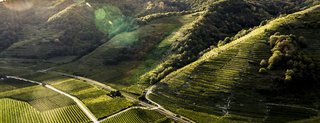
Kaiserberg
Facts:
- Town:
- Dürnstein
- Size in ha:
- 18,74
- Altitude in m:
- 203 - 379
- Aspect:
- S - SE
- Average Slope in %:
- 41
- Max. Slope in %:
- 90
- Insolation in hours per year:
- 2040
- Terraced vineyard:
- Yes
- Distance to Danube in m:
- 219
- Labour required in h:
- 24.400
- First documentary evidence:
- 1450
Description
The steep slopes between Weißenkirchen and Spitz have resounding names. The mountain in the middle bears the most impressive name of all: Kaiserberg Even if the name suggests a different meaning, the late documentation of this vineyard name leads to the conclusion that it originates from a family name.
Soil Profile Kaiserberg
"The Kaiserberg is composed of the metamorphic rocks migmatite-amphibolite and paragneiss. Migmatites are formed by the partial melting of rocks. Amphibolites are dark rocks with high concentrations of minerals from the amphibole group. Hornblends are their most common representative. Paragneiss is also a metamorphic rock, however, it was not subject to melting.
In the profile from the Kaiserberg, the upper part is dominated by weathered paragneiss with massive carbonate precipitation. Underneath, there are compact dark amphibolites, which are more resistant to weathering."








